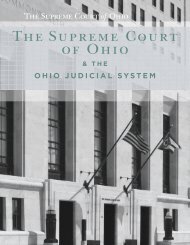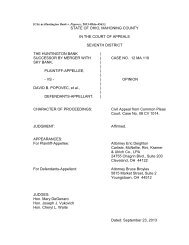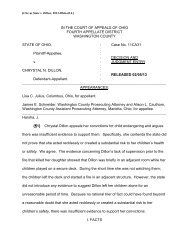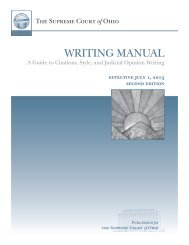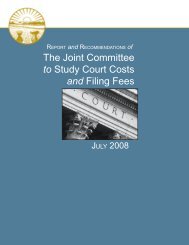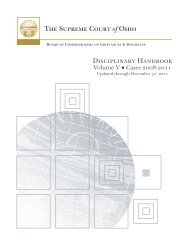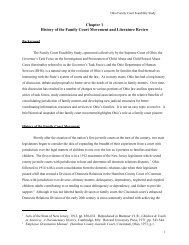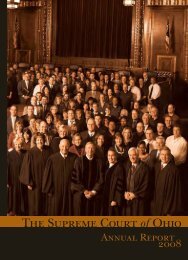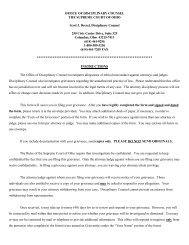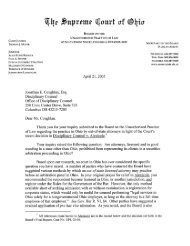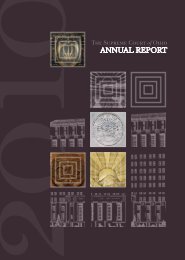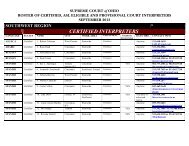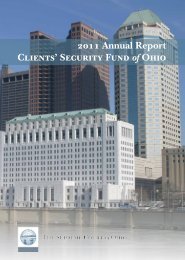State v. Winters - Supreme Court of Ohio - State of Ohio
State v. Winters - Supreme Court of Ohio - State of Ohio
State v. Winters - Supreme Court of Ohio - State of Ohio
You also want an ePaper? Increase the reach of your titles
YUMPU automatically turns print PDFs into web optimized ePapers that Google loves.
[Cite as <strong>State</strong> v. <strong>Winters</strong>, 2011-<strong>Ohio</strong>-141.]<br />
IN THE COURT OF APPEALS OF OHIO<br />
SIXTH APPELLATE DISTRICT<br />
FULTON COUNTY<br />
<strong>State</strong> <strong>of</strong> <strong>Ohio</strong> <strong>Court</strong> <strong>of</strong> Appeals No. F-10-010<br />
v.<br />
Appellee Trial <strong>Court</strong> No. 09CR184<br />
Jondale R. <strong>Winters</strong> DECISION AND JUDGMENT<br />
Appellee Decided: January 14, 2011<br />
* * * * *<br />
Scott A. Haselman, Fulton County Prosecuting Attorney, for appellee.<br />
Brian D. Smith, for appellant.<br />
HANDWORK, J.<br />
* * * * *<br />
{ 1} This appeal is from the May 3, 2010 judgment <strong>of</strong> the Fulton County <strong>Court</strong> <strong>of</strong><br />
Common Pleas, which sentenced appellant, Jondale <strong>Winters</strong>, after he was convicted by a<br />
jury <strong>of</strong> violating R.C. 2923.24(A), possessing criminal tools, a felony <strong>of</strong> the fifth degree,<br />
R.C. 2923.03(A) and R.C. 2913.02(A)(1), complicity to commit theft, a felony <strong>of</strong> the fifth
degree. Upon consideration <strong>of</strong> the assignments <strong>of</strong> error, we affirm the decision <strong>of</strong> the<br />
lower court. Appellant asserts the following assignments <strong>of</strong> error on appeal:<br />
2.<br />
{ 2} "I. The <strong>State</strong> failed to produce sufficient evidence to convict the<br />
Defendant-Appellant <strong>of</strong> complicity to [sic] theft and possession <strong>of</strong> criminal tools, violating<br />
due process.<br />
{ 3} "II. The Defendant-Appellant's conviction <strong>of</strong> complicity to [sic] theft and<br />
possession <strong>of</strong> criminal tools is against the manifest weight <strong>of</strong> the evidence.<br />
{ 4} "III. The trial <strong>Court</strong> erred in allowing presentation <strong>of</strong> a video recording<br />
that the Prosecutor did not provide to the Defendant or his counsel prior to the day <strong>of</strong> trial.<br />
{ 5} "IV. The Defendant-Appellant received ineffective assistance <strong>of</strong> counsel."<br />
{ 6} On December 22, 2009, appellant was indicted in a multi-count indictment<br />
alleging violations <strong>of</strong> R.C. 2913.02(A)(1), complicity to commit theft, and R.C.<br />
2923.24(A), possession <strong>of</strong> criminal tools. The following evidence was presented at trial.<br />
In addition to witnesses testimony, the prosecution also submitted copies <strong>of</strong> the<br />
surveillance recordings from that night. The surveillance recording <strong>of</strong> the parking lot<br />
showed appellant and two companions arrived at the Wal-Mart in Wauseon, <strong>Ohio</strong>, at 3:05<br />
a.m. on November 29, 2009. A man wearing a hooded sweatshirt, Steven Ostrander,<br />
exited from the back seat <strong>of</strong> the vehicle, which was driven by Jennifer Reichard, put on his<br />
Carhartt coat, and immediately entered the store. Appellant, a front seat passenger, and<br />
Reichard entered the store five minutes later. Appellant, who is bald, was wearing a black<br />
coat and blue jeans and sometimes a blue stocking cap. As appellant entered the store, he
kept his head turned sharply to the left while he entered the store, which the asset<br />
protection coordinator testified is commonly done so that the face would not be visible on<br />
the camera. Reichard wore a white coat, which she later draped over the infant seat at the<br />
front <strong>of</strong> the shopping cart covering her large purse. The asset protection coordinator for<br />
Wal-Mart testified that this is a common method shoplifters use to hide merchandise.<br />
Furthermore, he testified that it is common with organized retail crime that individuals<br />
work as a group. They pretend not to know one another, and while two people strip and<br />
conceal the merchandise, the other person serves as a lookout.<br />
3.<br />
{ 7} A cashier at the Wauseon Wal-Mart, testified that she was working that<br />
morning and noticed the sensor alarms, which sounded at the cash register, were not going<br />
<strong>of</strong>f as people entered the store, but were going <strong>of</strong>f as they exited. Normally, when the<br />
alarm is sounded, another employee stops the person at the door. The cashier went to the<br />
door to check and found the greeter at the door had checked the person after the sensors<br />
went <strong>of</strong>f and he did not have anything. The greeter testified that when the alarm sounded,<br />
appellant was exiting the store. The greeter stopped appellant, whom the greeter described<br />
as the man without the stocking cap, but he did not have anything on him. The greeter<br />
testified that appellant showed the greeter his cell phone and the greeter let him go because<br />
he knew that the sensor can sometimes be set <strong>of</strong>f by things other than security tags. There<br />
was no surveillance video <strong>of</strong> this area presented at trial.<br />
{ 8} Because the cashier was suspicious, she told another cashier that she thought<br />
something was going on and that person called the manager. The night manager testified
that after he was notified, he walked the store and observed two men and one woman.<br />
One <strong>of</strong> the men and the woman were together and they seemed to move whenever the<br />
manager came around.<br />
4.<br />
{ 9} The surveillance recording shows that appellant and Ostrander entered the<br />
electronics department from separate directions at 3:13 a.m. Both men wandered around<br />
and in and out <strong>of</strong> the department for the next 45 minutes scanning the merchandise. The<br />
asset protection coordinator testified that while the men were in the electronics department<br />
they scanned the merchandise like a shoplifter, rather than an ordinary customer. Reichard<br />
is seen coming in and out <strong>of</strong> the department several times.<br />
{ 10} The asset protection coordinator, who was watching the surveillance tape at<br />
the time, watched Reichard as she entered the infant department, moved into the<br />
electronics department, and then passed into the toy department where there were no<br />
surveillance cameras. He saw the men take items into the toy department and disappear<br />
<strong>of</strong>f camera. Afterward, Reichard left the area with a draped cart and headed for the<br />
grocery isle. The men left in a different direction, went around the cash registers, along<br />
the front <strong>of</strong> the store, in and out <strong>of</strong> the bathrooms, and eventually exited the store together.<br />
One <strong>of</strong> the police <strong>of</strong>ficers also watched the video and viewed the electronics area. He<br />
believed that appellant was in the area <strong>of</strong> the products that were found in the car, but the<br />
<strong>of</strong>ficer could not see appellant actually shoplifting. The night manager watched the men<br />
on the video for a short time, but did not see the men concealing merchandise.
5.<br />
{ 11} The cashier continued to watch the exit and relieved the greeter at the door<br />
for a short period <strong>of</strong> time. Around 4:30 a.m., the cashier saw a bald-headed man, whom<br />
she identified as appellant, leave and then return to the store. He made a comment to her<br />
that he had the wrong set <strong>of</strong> keys or needed keys from his buddy. Appellant hung around<br />
the bathrooms and cash registers and talked to someone near the women's clothing area.<br />
When the cashier saw Ostrander had entered the bathroom, the cashier had the greeter go<br />
into the bathroom to check to see if Ostrander was stealing something. The greeter<br />
returned and said that there was a man in the stall who was opening something. The<br />
cashier sent the greeter back into the restroom and then she saw appellant go into the<br />
bathroom for a short time. During the time he was in the restroom, the greeter testified, he<br />
overheard one man ask the other man for a set <strong>of</strong> keys. The greeter believed that appellant<br />
was in the stall and the other man, the one "with a stocking cap," came in asking for the<br />
keys. Shortly thereafter, both men exited the store without setting <strong>of</strong>f the alarms. At the<br />
same time, the manager called the police. The greeter checked the stall and found<br />
merchandise packaging for two Boost cell phones.<br />
{ 12} The cashier watched the men get into a silver car and drive to a nearby gas<br />
station. When the police arrived, the cashier told the <strong>of</strong>ficers about her suspicions and<br />
where she thought the men had driven. The packaging for a GPS was found in the parking<br />
lot. The manager recognized the merchandise packaging for the two cell phones and the<br />
GPS as merchandise sold in the electronics department. The GPS was accessible to<br />
consumers at that time, but the phones were locked up with a magnetic key. He also
testified that expensive video games, with a price over $49.99, are kept in a case locked<br />
with a key, but that all <strong>of</strong> the locks can be easily jimmied open.<br />
6.<br />
{ 13} Two police <strong>of</strong>ficers came to investigate. They were met by some <strong>of</strong> the<br />
employees who gave a description <strong>of</strong> the vehicle and suspects. At that time, the silver car<br />
was leaving the gas station and one <strong>of</strong> the <strong>of</strong>ficers left to apprehend the suspects in the<br />
vehicle. The other <strong>of</strong>ficer entered the store to talk to Reichard who was still inside the<br />
store. He found Reichard, the woman described by the employees, and took her to the<br />
scene where the car had been stopped.<br />
{ 14} The <strong>of</strong>ficers discovered that the car was registered to Reichard. Upon a<br />
search <strong>of</strong> the car, the <strong>of</strong>ficers found that it was filled with clothes and other items scattered<br />
around the car. In the glove box they found two Boost Mobile phones. There was a<br />
Garmin GPS in the back seat, but not in a box. Initially, the <strong>of</strong>ficers did not think the GPS<br />
had been stolen but retrieved it when the employees found the packaging in the parking<br />
lot. In the trunk, there were video games in a trash bag. They did not find any Wal-Mart<br />
shopping bags or receipts. The video games were in their packaging and had Wal-Mart<br />
price stickers on them. The <strong>of</strong>ficers only removed items that were in their original<br />
packaging or had a Wal-Mart price tag. The <strong>of</strong>ficer gave an employee the items to scan<br />
and create a receipt. After the <strong>of</strong>ficers learned that the GPS was stolen, they returned with<br />
some additional items from the car to scan on a separate receipt. The first receipt totaled<br />
$702.92 and the second, $39.59. The phones and GPS had serial numbers that the <strong>of</strong>ficers<br />
could match to the packaging that was found.
7.<br />
{ 15} The night manager testified that the serial numbers on the phones matched<br />
the packaging found in the store. The other items could not be traced that way. While the<br />
manager knew that the store carried the types <strong>of</strong> items that were recovered, he could not<br />
verify that the merchandise had been stolen from the store. The cashier and the asset<br />
protection coordinator also testified that there was no way to know if the merchandise had<br />
been in their inventory.<br />
{ 16} A support manager for Wal-Mart, testified that she was also called by the<br />
manager to walk the floor that morning because there was a potential problem. She went<br />
to the grocery isles and began to observe a woman walking the isle looking at things. She<br />
was observing the woman when a police <strong>of</strong>ficer arrived and escorted the woman outside.<br />
The <strong>of</strong>ficer returned with some merchandise and the support manager scanned the UPC<br />
codes on each piece <strong>of</strong> merchandise as a purchase to record the items and determine the<br />
value <strong>of</strong> everything. In addition to the phones and GPS, there were also Wii games, video<br />
games, Nintendo DS games, a charger, a memory card, scarf, and sunglasses. When she<br />
scanned the item, the cash register would pull up the price. If the item was not available at<br />
Wal-Mart, she would not have been able to obtain a price for it. But, she could not tell at<br />
that moment if there was stock missing. She testified that she could make such a<br />
determination from an inventory, but she did not take an inventory.<br />
{ 17} When one <strong>of</strong> the <strong>of</strong>ficers searched Reichard's purse, he found a 9" x 12" bag<br />
made out <strong>of</strong> tin foil and duct tape with a CO2 canister for a paint ball gun inside, a pair <strong>of</strong><br />
scissors, a utility knife, and an Inview S-3 magnetic key wrapped in foil. The key was
inside the lining <strong>of</strong> the purse. The <strong>of</strong>ficer did not find any Wal-Mart shopping bags or<br />
receipts.<br />
8.<br />
{ 18} The other <strong>of</strong>ficer testified that appellant, who was the driver, did not have a<br />
driver's license. Both men denied having been at Wal-Mart and said that they had just<br />
arrived from Michigan and had stopped only at the gas station. Appellant indicated that he<br />
was headed to Maumee, but was traveling southbound because <strong>of</strong> Ostrander's directions.<br />
The <strong>of</strong>ficer observed that appellant met the description <strong>of</strong> the man provided by the Wal-<br />
Mart employees. The <strong>of</strong>ficer patted appellant down and discovered cutting snips that were<br />
6-8" long and an approximately 6" x 2" piece <strong>of</strong> foil that was folded. Appellant could not<br />
give an explanation for having the foil. Nothing was found on Ostrander, but the <strong>of</strong>ficer<br />
observed that there was a pair <strong>of</strong> black and yellow snips on the front passenger seat where<br />
Ostrander had been sitting.<br />
{ 19} Ostrander testified, on behalf <strong>of</strong> the defense, that he is a recovering heroin<br />
addict and on November 28, he had called appellant and Reichard to request that they pick<br />
him up at his home in Maumee because he was having withdrawal symptoms (feeling sick<br />
and was sweating) and needed help until he could get into the methadone clinic in Monroe,<br />
Michigan, the next morning. He directed them to drive through Wauseon on the way to<br />
their home in Clayton, Michigan. When he got in the car, he noted that it was like a<br />
dumpster and joked about whether they were making a trash run. Reichard told him that<br />
the items in the bag were gifts for her children. Ostrander looked in the bag, which was
about one-quarter full, and saw some video games, a scarf, a teddy bear, etc. Ostrander<br />
wanted to lie down so he asked Reichard to move the bag to the trunk.<br />
9.<br />
{ 20} Appellant and Reichard decided to stop at the Wal-Mart in Wauseon to get<br />
some groceries, arriving about 3:15 a.m. Ostrander entered the store first because<br />
appellant and Reichard were talking. Despite his testimony that he was ill and sweating,<br />
he put on a coat over his sweatshirt prior to entering the store. Ostrander testified that he<br />
just aimlessly walked around the store because he did not feel well. He passed appellant<br />
several times, sometimes talking to him and sometimes not. He knew that appellant was<br />
watching him to make sure he was okay.<br />
{ 21} Ostrander stated that when he ended up in the electronics department and<br />
saw the GPS units, he decided right then to steal one. He took it into the sporting goods<br />
and then hardware departments to remove the security slide and packaging. He concealed<br />
it in his overcoat that he had removed and then went to the bathroom at the rear <strong>of</strong> the<br />
store. Ostrander intended to smoke, but did not have any keys, so he located appellant and<br />
retrieved the keys before leaving the store. Appellant actually left the store shortly before<br />
Ostrander because he was moving very slowly. Ostrander then left the store carrying his<br />
coat, with the GPS inside, and phone. When the sensor went <strong>of</strong>f, he ran his arm carrying<br />
his coat and the phone pass the sensor and indicated to the greeter that the phone must<br />
have set it <strong>of</strong>f. Appellant asked Ostrander if he had stolen anything, but he did not admit<br />
to it.
10.<br />
{ 22} After getting into the car, Ostrander sat there for awhile while appellant went<br />
back into the store. While he sat there, Ostrander opened up the GPS and removed the<br />
security buzzer and threw it outside the car. After awhile, he returned to the store, leaving<br />
his overcoat behind, but wearing a sweatshirt. This time, he returned to the electronics<br />
department and concealed the two Boost phones under his sweatshirt. Ostrander ran into<br />
appellant and asked him to buy a pop because he was not feeling well. After appellant<br />
purchased the pop, Ostrander went into the restroom because he knew that he could not<br />
leave the store with the packaging <strong>of</strong> the phones without setting <strong>of</strong>f the sensors again.<br />
{ 23} While he was in the back stall removing the packaging, he could hear<br />
someone walk into the restroom. He also heard appellant come into the restroom and he<br />
asked for the key to the car. Ostrander left the packaging behind and concealed the phones<br />
in his coat. When Ostrander came out <strong>of</strong> the stall, he saw the greeter and gave appellant<br />
the keys to the car. Appellant left the store, followed a few minutes later by Ostrander,<br />
who did not set the sensors <strong>of</strong>f.<br />
{ 24} Knowing that the greeter and a cashier were on to him, Ostrander suggested<br />
the two men decide to go to a nearby gas station to get some cigarettes because appellant<br />
could not find any in the car. While he was about to buy some cigarettes at the gas station,<br />
appellant called him and told him that he found some in the car. When Ostrander returned<br />
to the car, he noticed the police cars at Wal-Mart and told appellant to drive Ostrander<br />
home immediately because he was very sick. Appellant did not want to leave Reichard in<br />
the store, but Ostrander convinced him to call her and explain. Appellant asked for
directions and Ostrander told appellant which way to turn so that they could get away from<br />
the store.<br />
11.<br />
{ 25} As the police were pulling the car over, Ostrander told appellant to deny<br />
having been at Wal-Mart. At the same time, appellant was questioning Ostrander as to<br />
whether he had stolen something from the gas station or Wal-Mart. Ostrander denied<br />
owning the snips that were found in the car and believed they belonged to appellant whom<br />
Ostrander knew was having trouble with his car stereo and had plans to fix it. Ostrander<br />
denied knowing that appellant and Reichard had foil, a magnetic key, and snips on them.<br />
{ 26} Ostrander testified that he did not get a deal for testifying, but was doing so<br />
only because appellant was his friend and believed that appellant should not get in trouble<br />
for something Ostrander did.<br />
{ 27} In his first assignment <strong>of</strong> error, appellant argues that there was insufficient<br />
evidence to convict him <strong>of</strong> complicity to commit theft and possession <strong>of</strong> criminal tools.<br />
{ 28} A challenge to the sufficiency <strong>of</strong> the evidence is a question <strong>of</strong> law. <strong>State</strong> v.<br />
Thompkins, 78 <strong>Ohio</strong> St.3d 380, 386, reconsideration denied (1997), 79 <strong>Ohio</strong> St.3d 1451.<br />
The standard for determining whether there is sufficient evidence to support a conviction<br />
is whether the evidence admitted at trial, "if believed, would convince the average mind <strong>of</strong><br />
defendant's guilt beyond a reasonable doubt. The relevant inquiry is whether, after<br />
viewing the evidence in a light most favorable to the prosecution, any rational trier <strong>of</strong> fact<br />
could have found the essential elements <strong>of</strong> the crime proven beyond a reasonable doubt."<br />
<strong>State</strong> v. Jenks (1991), 61 <strong>Ohio</strong> St.3d 259, paragraph two <strong>of</strong> the syllabus, citing Jackson v.
Virginia (1979), 443 U.S. 307. See, also, <strong>State</strong> v. Thompkins, supra. Therefore, "[t]he<br />
verdict will not be disturbed unless the appellate court finds that reasonable minds could<br />
not reach the conclusion reached by the trier-<strong>of</strong>-fact." <strong>State</strong> v. Dennis (1997), 79 <strong>Ohio</strong><br />
St.3d 421, 430, certiorari denied (1998), 522 U.S. 1128, citing <strong>State</strong> v. Jenks, supra. In<br />
determining whether the evidence is sufficient to support the conviction, the appellate<br />
court does not weigh the evidence nor assess the credibility <strong>of</strong> the witnesses. <strong>State</strong> v.<br />
Walker (1978), 55 <strong>Ohio</strong> St.2d 208, 212-213, certiorari denied (1979), 441 U.S. 924. But,<br />
the court must view the evidence in the light most favorable to the prosecution. <strong>State</strong> v.<br />
Jenks, supra. If the state "* * * relies on circumstantial evidence to prove an element <strong>of</strong><br />
the <strong>of</strong>fense charged, there is no requirement that the evidence must be irreconcilable with<br />
any reasonable theory <strong>of</strong> innocence in order to support a conviction" so long as the jury is<br />
properly instructed as to the burden <strong>of</strong> pro<strong>of</strong>, i.e., beyond a reasonable doubt. <strong>State</strong> v.<br />
Jenks, supra, at paragraph one <strong>of</strong> the syllabus.<br />
12.<br />
{ 29} R.C. 2923.03(A)(2) provides that "[n]o person, acting with the kind <strong>of</strong><br />
culpability required for the commission <strong>of</strong> an <strong>of</strong>fense, shall * * * [a]id or abet another in<br />
committing the <strong>of</strong>fense." Furthermore, R.C. 2913.02(A)(1) provides that "[n]o person,<br />
with purpose to deprive the owner <strong>of</strong> property or services, shall knowingly obtain or exert<br />
control over either the property or services * * * [w]ithout the consent <strong>of</strong> the owner or<br />
person authorized to give consent." If the value <strong>of</strong> the property stolen is more than $500<br />
but less than $5,000, the <strong>of</strong>fense is a felony <strong>of</strong> the fifth degree. R.C. 2913.02(B)(2). R.C.
2923.24(A) provides that: "(A) No person shall possess or have under the person's control<br />
any substance, device, instrument, or article, with purpose to use it criminally."<br />
13.<br />
{ 30} Appellant argues that there was insufficient evidence presented to support a<br />
finding that he stole anything from the store since none <strong>of</strong> the witnesses could testify that<br />
they saw appellant attempting to shoplift or actually remove anything from the store and<br />
Ostrander admitted to stealing the phones and GPS on his own without appellant's<br />
knowledge. Furthermore, there was insufficient evidence to support a finding that the<br />
property stolen was valued over $500 since the only evidence that can be traced back to<br />
the store is the two phones and GPS unit, with a total value <strong>of</strong> $368.96.<br />
{ 31} Upon a review <strong>of</strong> the evidence, we find that there was sufficient direct and<br />
circumstantial evidence presented to submit the case to the jury. As to the complicity<br />
charge, appellant was seen in the company <strong>of</strong> one who admitted to stealing the phones and<br />
GPS; stolen merchandise was found in the car he occupied; he carried shoplifting tools;<br />
the majority <strong>of</strong> the stolen items are <strong>of</strong> the type that could be found in the electronics<br />
department where appellant spent most <strong>of</strong> his time; and appellant's behavior, and that <strong>of</strong><br />
his companions during the entire event, was identified by the asset protection coordinator<br />
as being similar to other organized retail shoplifting groups (entering separately, hiding his<br />
face from the camera, pretending not to know Ostrander, passing in and out <strong>of</strong> the<br />
electronics department repeatedly over an extended period <strong>of</strong> time, meeting up with<br />
Reichard at times, entering the bathroom repeatedly, and scanning the merchandise rather<br />
than acting like a typical shopper).
14.<br />
{ 32} Furthermore, as to whether the prosecution proved that all <strong>of</strong> the<br />
merchandise retrieved from the car was stolen, we find that the jury could have reasonably<br />
inferred from the direct evidence (that phones and a GPS were stolen) that the Wal-Mart<br />
merchandise found in the car and in a garbage bag in the trunk was stolen that night as<br />
well. The jury could also reasonably infer from the direct evidence that appellant and<br />
Ostrander drove to a nearby gas station, had the opportunity to transfer stolen items from<br />
the car, and place them in the garbage bag in the trunk where they were later found by the<br />
police. Therefore, we find appellant's first assignment <strong>of</strong> error not well-taken.<br />
{ 33} In his second assignment <strong>of</strong> error, appellant argues that his conviction <strong>of</strong><br />
complicity to commit theft and possession <strong>of</strong> criminal tools is contrary to the manifest<br />
weight <strong>of</strong> the evidence.<br />
{ 34} Even when there is sufficient evidence to support the verdict, a court <strong>of</strong><br />
appeals may decide that the verdict is against the weight <strong>of</strong> the evidence. <strong>State</strong> v.<br />
Thompkins, supra, at paragraph two <strong>of</strong> the syllabus. When weighing the evidence, the<br />
court <strong>of</strong> appeals must consider whether the evidence in a case is conflicting or where<br />
reasonable minds might differ as to the inferences to be drawn from it, consider the weight<br />
<strong>of</strong> the evidence, and consider the credibility <strong>of</strong> the witnesses to determine if the jury<br />
clearly "lost its way, and created such a manifest miscarriage <strong>of</strong> justice that the conviction<br />
must be reversed and a new trial ordered." <strong>State</strong> v. Thompkins, supra, at 387. See, also,<br />
<strong>State</strong> v. Smith (1997), 80 <strong>Ohio</strong> St.3d 89, 114, certiorari denied (1998), 523 U.S. 1125.
15.<br />
{ 35} While there was some conflicting evidence presented in this case and<br />
elements that were proven solely by circumstantial evidence, when all <strong>of</strong> the evidence is<br />
considered as a whole, we find that the jury did not lose its way in evaluating the evidence<br />
and drawing inferences from the direct evidence. Therefore, we find that appellant's<br />
convictions were not contrary to the manifest weight <strong>of</strong> the evidence. Appellant's second<br />
assignment <strong>of</strong> error is not well-taken.<br />
{ 36} In his third assignment <strong>of</strong> error, appellant argues that the trial court erred in<br />
allowing presentation <strong>of</strong> a video recording that the prosecutor did not provide to the<br />
appellant prior to trial.<br />
{ 37} During the trial, the prosecution obtained a copy <strong>of</strong> a continuous video<br />
recording <strong>of</strong> Reichard's car from the time the group arrived at the Wal-Mart until the time<br />
appellant and Ostrander left the parking lot. The prosecution had already obtained an<br />
edited copy <strong>of</strong> the same scene prepared by the asset protection coordinator at Wal-Mart.<br />
The prosecution and defense both indicated in opening statements that there was only a<br />
video showing appellant arriving and leaving. However, after the greeter gave conflicting<br />
testimony to the cashier about who was in the stall removing merchandise from its<br />
packaging, the asset protection coordinator who was at trial notified the prosecution that<br />
there was an extended version <strong>of</strong> the videotape <strong>of</strong> the car. During a recess, he showed the<br />
video to the prosecution and defense counsel. The prosecution wanted to use the extended<br />
version <strong>of</strong> the video at trial because <strong>of</strong> the conflicting testimonies presented by the cashier
and greeter. Appellant objected to the admission <strong>of</strong> the evidence. The court overruled the<br />
objection finding that the probative value outweighed the prejudicial effect.<br />
part that:<br />
16.<br />
{ 38} Former Crim.R. 16(B)(1)(c), effective July 1, 1973, provided in pertinent<br />
{ 39} "(B) Disclosure <strong>of</strong> evidence by the prosecuting attorney<br />
{ 40} "(1) Information subject to disclosure.<br />
{ 41} "(c) Documents and tangible objects. Upon motion <strong>of</strong> the defendant the court<br />
shall order the prosecuting attorney to permit the defendant to inspect and copy or<br />
photograph books, papers, documents, photographs, tangible objects, buildings or places,<br />
or copies or portions there<strong>of</strong>, available to or within the possession, custody or control <strong>of</strong><br />
the state, and which are material to the preparation <strong>of</strong> his defense, or are intended for use<br />
by the prosecuting attorney as evidence at the trial, or were obtained from or belong to the<br />
defendant."<br />
{ 42} Sanctions for violating Crim.R. 16(B) may be sought if the defendant can<br />
demonstrate that: "(1) the prosecution's failure to disclose was a willful violation <strong>of</strong> the<br />
rule, (2) foreknowledge <strong>of</strong> the information would have benefited the accused in the<br />
preparation <strong>of</strong> his defense, and (3) the accused suffered some prejudicial effect. <strong>State</strong> v.<br />
Parson (1983), 6 <strong>Ohio</strong> St.3d 442, 445." <strong>State</strong> v. Joseph (1995), 73 <strong>Ohio</strong> St.3d 450, 458,<br />
certiorari denied (1996), 516 U.S. 1178.<br />
{ 43} The prosecution is required to provide the defense with access to any<br />
evidence intended to be used at trial. Crim.R. 16(B)(1)(c). But, the state is only required
to provide the defense with evidence that is within the state’s possession or control. <strong>State</strong><br />
v. Morgan, 12th Dist. No. CA2008-08-035, 2009-<strong>Ohio</strong>-6050, 23. Furthermore, evidence<br />
that was not available until the time <strong>of</strong> trial need not be excluded simply because the<br />
prosecution could not notify the defense <strong>of</strong> the evidence prior to trial. <strong>State</strong> v. Clark (Aug.<br />
5, 1992), 1st Dist. No. C-910541, at 2.<br />
17.<br />
{ 44} Here, the prosecution only intended to use the edited videotape at trial.<br />
However, at trial, when one <strong>of</strong> its witnesses gave unexpected conflicting testimony, the<br />
prosecution learned that there was a video recording to substantiate that Ostrander entered<br />
the bathroom first and appellant is the man who returned to the store and followed<br />
Ostrander and the greeter into the bathroom to retrieve a set <strong>of</strong> keys. It also provided<br />
additional evidence that appellant entered and exited the store several times, a fact which<br />
the defense indicated in opening remarks could not be proven. We conclude that the state<br />
did not violate Crim.R. 16(B)(1)(c) since the tape was not in the prosecution's possession<br />
prior to trial. Furthermore, the surveillance video merely confirmed the testimony <strong>of</strong> the<br />
cashier that appellant entered and left the store several times.<br />
{ 45} Appellant's third assignment <strong>of</strong> error is not well-taken.<br />
{ 46} In his fourth assignment <strong>of</strong> error, appellant argues that his appointed counsel<br />
rendered ineffective assistance.<br />
{ 47} Appellant bears the burden <strong>of</strong> proving that his counsel was ineffective since<br />
an attorney is presumed competent. Strickland v. Washington (1984), 466 U.S. 668, 689,<br />
and <strong>State</strong> v. Lott (1990), 51 <strong>Ohio</strong> St.3d 160, 174, certiorari denied (1990), 498 U.S. 1017.
To meet this burden <strong>of</strong> pro<strong>of</strong>, appellant must show that: (1) there was a substantial<br />
violation <strong>of</strong> the attorney's duty to his client, and (2) the defense was prejudiced by the<br />
attorney's actions or breach <strong>of</strong> duty. Strickland, supra, at 687-699, and <strong>State</strong> v. Smith<br />
(1985), 17 <strong>Ohio</strong> St.3d 98, 100. When the claims <strong>of</strong> ineffective assistance <strong>of</strong> counsel are<br />
based upon facts outside the appellate record, the issue must be raised in a petition for<br />
postconviction relief, not on direct appeal. <strong>State</strong> v. Hartman (2001), 93 <strong>Ohio</strong> St.3d 274,<br />
299, and <strong>State</strong> v. Cooperrider (1983), 4 <strong>Ohio</strong> St.3d 226, 228.<br />
18.<br />
{ 48} Appellant asserts that his counsel rendered ineffective assistance because he<br />
failed to obtain transcripts from the preliminary hearing for cross-examination purposes.<br />
Appellant asserts that the witnesses made inconsistent statements. Appellant's counsel did<br />
cross-examine the greeter to ensure that he was not confusing the two men. While he<br />
asked if the greeter remembered his earlier testimony at the preliminary hearing, the<br />
attorney could not impeach the greeter's testimony without the alleged prior inconsistent<br />
statement.<br />
{ 49} Since we do not have the preliminary hearing transcript before us, nor do we<br />
know why the attorney did not order a copy <strong>of</strong> it, we cannot compare the testimonies at<br />
that hearing to the testimonies at trial. Furthermore, in his closing argument, appellant's<br />
attorney referred to the conflicting testimonies between the witnesses to bolster<br />
Ostrander's testimony that he was the only one shoplifting. Without additional evidence<br />
outside the appellate record, we cannot determine if this was trial strategy or ineffective
assistance. Thus, this issue cannot be determined on direct appeal. Appellant's fourth<br />
assignment <strong>of</strong> error is found not well-taken.<br />
19.<br />
{ 50} Having found that the trial court did not commit error prejudicial to<br />
appellant and that substantial justice has been done, the judgment <strong>of</strong> the Fulton County<br />
<strong>Court</strong> <strong>of</strong> Common Pleas is affirmed. Appellant is hereby ordered to pay the costs <strong>of</strong> this<br />
appeal pursuant to App.R. 24.<br />
JUDGMENT AFFIRMED.<br />
A certified copy <strong>of</strong> this entry shall constitute the mandate pursuant to App.R. 27. See,<br />
also, 6th Dist.Loc.App.R. 4.<br />
Peter M. Handwork, J. _______________________________<br />
JUDGE<br />
Mark L. Pietrykowski, J.<br />
_______________________________<br />
Thomas J. Osowik, P.J. JUDGE<br />
CONCUR.<br />
_______________________________<br />
JUDGE<br />
This decision is subject to further editing by the <strong>Supreme</strong> <strong>Court</strong> <strong>of</strong><br />
<strong>Ohio</strong>'s Reporter <strong>of</strong> Decisions. Parties interested in viewing the final reported<br />
version are advised to visit the <strong>Ohio</strong> <strong>Supreme</strong> <strong>Court</strong>'s web site at:<br />
http://www.sconet.state.oh.us/rod/newpdf/?source=6.



